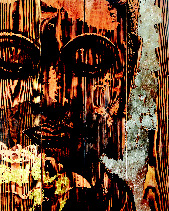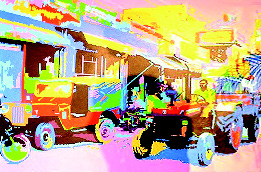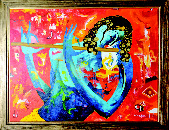The acquisition of Modern Art, as yet another symbol of having 'arrived' at a certain 'contemporary lifestyle', becomes an inevitable part of a Millennium Citizen's cycle of frenetic social aspirations. However, with a dearth of galleries to provide easy art-viewing, alternate venues for the display and sale of art have come up. Galaxy Hotel inventively opened its main cafe and lobby spaces for a series of noteworthy art-exhibitions last year. Pllazio Hotel then showcased curated modern art exhibits across its stairways and restaurant areas. Five-star Hotels possess the essential luxuries of space, ambience, lighting and active international audiences --- all requisites for effective displays of Fine Art.
These curated shows had been organised well, with all the expected 'gallery parameters' – including informed Curation, sophisticated Vernissages or Opening-Nights with cocktails, and special invitees. Subsequently, one has also noticed a parallel initiative --- that of home-decor and lifestyle-stores in malls, showing tentative displays of art alongside their stores, and organising art-competitions within mall-spaces – in some new shopping units such as Ninex Mall (on Sohna Road).
As part of this 'Aspiring Art' phenomenon, the current winter season has seen yet another Gurgaon 5-Star Hotel open its public spaces to the display of Modern Indian Art. The Marriott Hotel's main lobby is now the venue of a collection of paintings by emerging artists, made available for view until 17 February, to all visitors and guests. At the cafe-lobby, known as Marriott Courtyard, 13 canvasses of four Delhi-based artists are on display.
The artists are Rohit Sharma, Suchit Sahni, Amar Sultan and Ramesh Kumar. These socially-visible artists, born in the 1960s and 70s, have developed consistent bodies of work over decades, and have exhibited frequently across India as well as in international group-shows. Although the Marriott display is not strictly a 'curated' exhibition, it showcases different recent works by these artists, with the paintings organised and provided by the Gurgaon art-enterprise 'Tad Arts' – with the cooperation of the Hotel.
All the artworks on display are large canvasses, painted in Oils and Acrylics --- mainly in a Figurative mode, while a few are Abstract. The most accomplished among these are the figurative and detailed paintings by Rohit and Amar, who have created distinctly recognisable idioms. The Abstract-landscape artworks
of Suchit too are on a fairly sophisticated plane. Ramesh's modern-mythological works are of a more kitschy nature. However, as there really is no accounting for tastes in the art-market, every artist must be provided a fair viewing.


The Delhiite, Rohit Sharma, born in 1978, graduated from the Delhi College of Art. He has evolved a signature 'Cow' series, that depicts colourfully-bedecked, serene, white Indian cows, jostling patiently with rickety three-wheeler scooters and quaintly-painted highway-trucks. As his backdrops he often uses Indian street-maps, applied texturally in a digital manner. His central canvas in this Exhibition may be described as 'Tantric-Op Art'. This pleasing canvas neo-realistically depicts his quintessential patient Indian Cow, placed in the centre of an auspicious red Tantric 'bindu'. It is like the vortex of a Buddhist-Hindu Lotus Chakra, which emanates an infinity of cosmic petals, painted in vintage sepia-tones – that seem to echo the texture of antique parchments.
Rohit's skilful draughtsmanship, delineating Indian Cows with photo-realism, lends an immediacy to his depictions. He vividly employs a warm Indian palette of marigold, saffron, haldi and leaf-greens with panache. In the painting under analysis, his interesting application of the Impressionist Pointillist technique, with thousands of minuscule red 'bindus' carefully painted within the larger central cosmic 'bindu', lends drama and depth to this quaint canvas. The painting --- albeit quite modern --- is also redolent with North India's visual history of decorative Rajasthani Pichwais, and the charm of other symbolic folk-art genres.


Amar Sultan was born in Mussoorie in 1977, and is known for a series of paintings based on card-games; that incorporate the metaphysical symbols and forms associated with packs of playing-cards. In such earlier works, Amar exemplified his graphic, illustrative and design sensibilities, along with a contemporary sense of colour. He also employed well-wrought classical Greco-Roman heads, placed as contrasts to his playing-card symbols.
Here, in his more recent experiments, Amar utilises more Indian visual inspirations, such as meditative Buddha-heads captured in Nirvanic moments. In a striking mixed-media vertical Buddha canvas painted in earth-tones, the artist has applied intricate graphic linear details that evoke the feeling of wood-cuts and etchings. He has also applied 'distressed' tonal elements, to lend a sense of antique texture, and the timeless concentric visual striations that may be seen in the bark of ancient trees. Amar's other large canvas on show here, depicting a cluster of grey Indian pigeons with two sepia heads is, by comparison, more naive, stiff and facile in its impact.


Suchit Sahni was born in Delhi in 1977, and has a Diploma from Delhi's Academy of Fine Arts. His 'Pop-Art' – influenced Delhi cityscapes employ a blend of realism and abstraction, with an overall 'Poster-digital' look, that tends to overpower their clarity of formation. As a result, one may detect hazy, floating 'human' elements fused into the abstract tonalities of his renditions, which merge all realistic elements seamlessly into an easy, 'decorative' manner of poster-art. The paintings that more clearly depict the vehicular chaos of India—with graphic details of buses, taxis, tractors and cars—bear greater visual impact than Suchit's more abstract experiments. While some of these works may be noticed for the use of translucent colour tones, the artist needs to further hone his clarity of concepts, representational abilities and drawing skills.


Ramesh Kumar, the seniormost artist of this group, was born in 1962 in Delhi. He attempts to depict Hindu icons in a neo-modernist manner, in acrylics on canvas. However, his formations are the most awkward in this Show, being sentimentalised with a palette that is too garish for the evolved eye. In this Exhibit, Ramesh has portrayed the popular divinities Krishna and Shiva, drawn in saccharine, one-dimensional postures that lack the essential Lasya and grace of genuine Hindu iconography. The glaring orange backgrounds to these blue Gods are a confusing amalgam of symbolic shapes, that go awry in their over-enthusiasm to embellish his work. The depiction of Divinity in Art requires an evolved Sadhana --- a very high discipline, involving intensive study of form, technique and the highest aesthetic parameters. Ramesh's awkward 'modern icon' paintings serve to indicate that such 'divine' representation must not be attempted by urban painters in haste.
Overall, the collection on view can best be described as a tentative beginning towards exposing the dynamism of Contemporary Indian Art within hotel interiors. More striking art, inclusive of Contemporary Sculpture and Photographic Art, must be collected and curated with greater focus. The works must also be displayed with more focused lighting. More evolved and original art needs to circulate in Gurgaon's hotels, as well as in its corporate environs --- thereby adding expressiveness to commercial ambiences.
As a point to note -- I caught sight of a series of other abstract canvasses placed permanently in the Marriott lobby and bar areas. I found it strange that these were unsigned paintings, and nobody was able to identify the names of their artists. Painted in acrylics in geometrical forms, in tones of red and black, these paintings are interesting in their Minimalism. Although these canvasses are not signed, they blend effectively with the current exhibits, and their artists deserve credit for adding dramatic nuance to neutral hotel interiors.
Artist, Writer, & Curator
Read More...